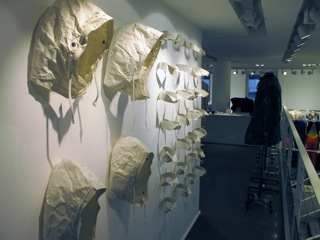Glorious Imperfection With Greg Lauren
Greg Lauren had already learned more about style by the time he was five or six years old than most people do in a lifetime. “Alteration,” his menswear show yesterday at Colette in Paris, began as a comment on man’s obsession with dressing the part, but has turned into Lauren’s entrée as a designer in his own right.
Ralph’s nephew, Greg, grew up watching Yankees games on television with his father Jerry, executive vice president for men’s design at Polo Ralph Lauren. After the game, father and son might tune into a Cary Grant classic. “I was learning at a very young age how a glen plaid suit could be beautiful. I appreciated Ernest Hemingway’s style long before I ever knew he was an author. Everything was about how it looked.” Years later in Los Angeles as an artist, Lauren began to scratch the surface of style. His paintings of superheroes, like Batman looking forlorn in a diner booth, led him to construct his own idealized suits inspired by Cary Grant, Gary Cooper and Jimmy Stewart. These art works are made out of fragile white paper and he has stitched each one on the sewing machine himself. What looks like a ghostly tuxedo can never be worn. It’s just a fragile facsimile which Lauren has severely crumpled, making his own dents in a perfect copy of a modern man’s impeccably elegant armor.
“Style was our personal language and I grew up knowing how to find the perfect vintage Cub Scout shirt,” he says. “I wore them, but I didn’t earn the badges.” Lauren was the go-to guy in high school about what to wear to prom. “I’d say: ‘Dude, you should really get a peak lapel, not a notch lapel.'” And in the seventh or eighth grade, he recalls “sort of unknowingly” pairing a repp stripe tie with a gingham check shirt. “I was thrilled when my dad said: ‘That’s very Duke of Windsor,’ but I was only thirteen years old.” Later on Lauren attended Princeton, “so that I could wear the clothing that looked great at Princeton,” and began to wonder if he hadn’t “inherited someone else’s heroes.”
After the paper menswear, Lauren spontaneously began making suits out of repurposed army tents, duffel bags, and blankets. “To a certain degree, this notion that you can be someone because of what you wear is what I find most interesting. It’s not that I’m rebelling against that. It’s just that I wanted to change the movie and the roles that I had played, to find a more authentic, personal feeling in my clothes. That’s when I started the collection.” For Lauren who says he still enjoys “dressing like Cary Grant, JFK or Gary Cooper, even though I feel more like Oliver Twist, or Charlie Chaplin,” understanding every detail of the ideal man’s wardrobe was the prerequisite he needed to be able to bulldoze the façade. His collection, in its third season, includes his artfully scruffy take on a navy men’s double-breasted blazer made out of vintage army tent fabric. There’s also his preferred peak lapel jacket in old duffel bag material, and the Paris Jacket, dreamed up on a wistful weekend visit here which includes a journal entry in the lining and part of a napkin from the Café de Flore. There’s even a new coat inspired by Batman’s cape.
The week before his show at Colette, Lauren was holed up in a borrowed apartment in Paris for a week with three seamstresses he brought over from Los Angeles to make pieces for Colette. “Actually they’re more than seamstresses. I found a great group of people who work in film costuming and I drive them crazy. When I want to skip a stitch, or sew in a crooked collar, I draw it on a piece of paper and they work it out.” Every piece in the collection is made by hand in Lauren’s studio.
At his retail and art installation in New York last year called “Barracks,” which explored modern man’s obsession with dressing in military gear and included his wearable pieces, Lauren’s uncle Ralph paid him a visit. “I had kept quiet about the clothes in the beginning because I didn’t want any advice. The first time I took my dad around was when my pieces were at Barneys. So with my uncle, it felt like a young artist being able to show his work to Picasso,” says Lauren. “It wasn’t, ‘Well, what do you think?,’ because I’m not looking for approval now, but he paid me the greatest compliment. He bought a jacket, put it on and made it his own.”







